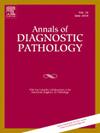Retroperitoneal schwannoma: A clinicopathological analysis of 14 cases
IF 1.4
4区 医学
Q3 PATHOLOGY
引用次数: 0
Abstract
Retroperitoneal schwannomas (RSs) are rare benign neurogenic tumors with nonspecific imaging features and histological mimics, posing significant diagnostic challenges. To address this gap, we retrospectively analyzed 14 RS cases to delineate clinicopathological and immunohistochemical characteristics. Cases were retrieved from the pathology database of the First Affiliated Hospital of Guangzhou Medical University (2019–2024), with hematoxylin-eosin (H&E) and immunohistochemical (IHC) staining performed for evaluation. Among 14 patients, the male/female ratio was 2:5 and the average age was 47.3 years (range, 28 to 71 years). Patients with RSs generally did not have specific symptoms, and they were usually found during routine medical examinations (9/14). All underwent total tumor resection, with a mean tumor size of 5.5 cm (range, 2.5 to 9.5 cm). Microscopically, typical schwannoma features were observed alongside degenerative changes, including cyst formation (6/14), hemorrhage (8/14), calcification (3/14), ossification (3/14), ossification with bone marrow elements (1/14), and degenerative nuclear atypia (5/14). Immunohistochemically, tumors were strongly positive for S-100 (12/12) and SOX10 (12/12), with focal EMA (1/3) and SMA (2/10) reactivity. Over a mean follow-up of 26.4 months (range, 2 to 68 months), 13 patients remained recurrence-free, while one experienced local recurrence after 43 months. Our findings highlight that RS diagnosis requires integrating clinical, radiological, morphological, and immunohistochemical analyses to distinguish these tumors from mimics. Despite their benign nature, long-term surveillance is advised due to the potential for recurrence. This study underscores the importance of a multidisciplinary approach in diagnosing and managing RSs.

腹膜后神经鞘瘤14例临床病理分析
腹膜后神经鞘瘤(RSs)是一种罕见的良性神经源性肿瘤,具有非特异性影像学特征和组织学模拟,给诊断带来了重大挑战。为了解决这一空白,我们回顾性分析了14例RS病例,以描述临床病理和免疫组织化学特征。从广州医科大学第一附属医院病理数据库(2019-2024)中检索病例,采用苏木精-伊红(H&;E)和免疫组化(IHC)染色进行评价。14例患者中,男女比例为2:5,平均年龄47.3岁(28 ~ 71岁)。RSs患者一般没有特定症状,通常在常规医学检查中发现(9/14)。所有患者均行肿瘤全切除术,平均肿瘤大小为5.5 cm(范围为2.5 ~ 9.5 cm)。镜下,典型的神经鞘瘤特征伴退行性改变,包括囊肿形成(6/14)、出血(8/14)、钙化(3/14)、骨化(3/14)、骨髓元素骨化(1/14)和退行性核异型(5/14)。免疫组化,肿瘤S-100(12/12)和SOX10(12/12)阳性,局灶性EMA(1/3)和SMA(2/10)阳性。平均随访26.4个月(2 - 68个月),13例患者无复发,1例患者在43个月后出现局部复发。我们的研究结果强调RS诊断需要综合临床、放射学、形态学和免疫组织化学分析来区分这些肿瘤和模拟肿瘤。尽管它们是良性的,但由于有复发的可能性,建议长期监测。这项研究强调了多学科方法在诊断和管理RSs中的重要性。
本文章由计算机程序翻译,如有差异,请以英文原文为准。
求助全文
约1分钟内获得全文
求助全文
来源期刊
CiteScore
3.90
自引率
5.00%
发文量
149
审稿时长
26 days
期刊介绍:
A peer-reviewed journal devoted to the publication of articles dealing with traditional morphologic studies using standard diagnostic techniques and stressing clinicopathological correlations and scientific observation of relevance to the daily practice of pathology. Special features include pathologic-radiologic correlations and pathologic-cytologic correlations.

 求助内容:
求助内容: 应助结果提醒方式:
应助结果提醒方式:


